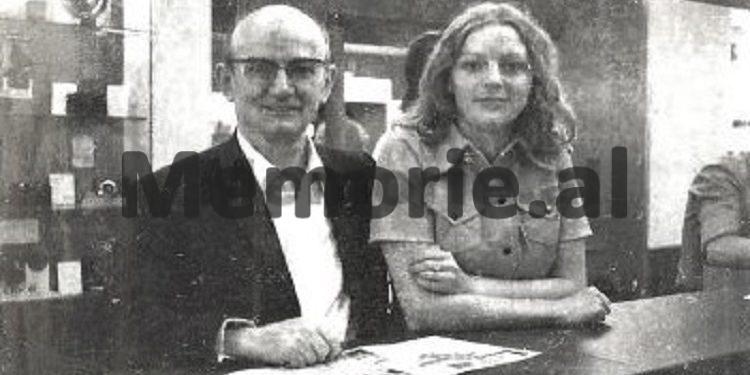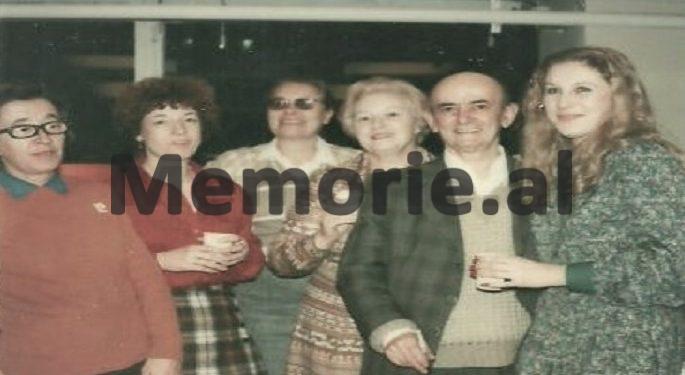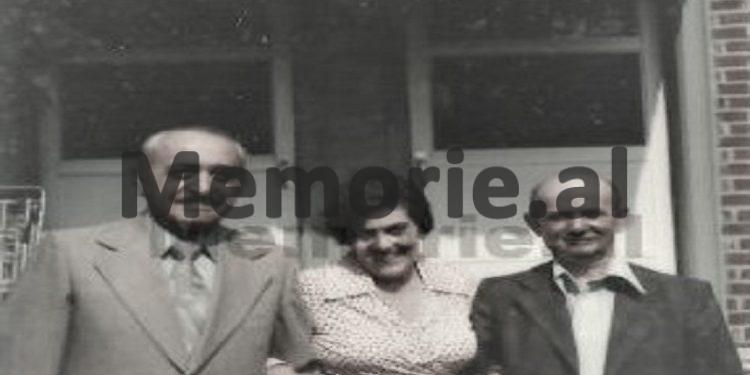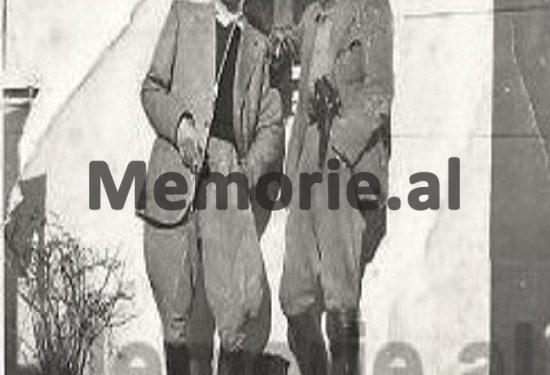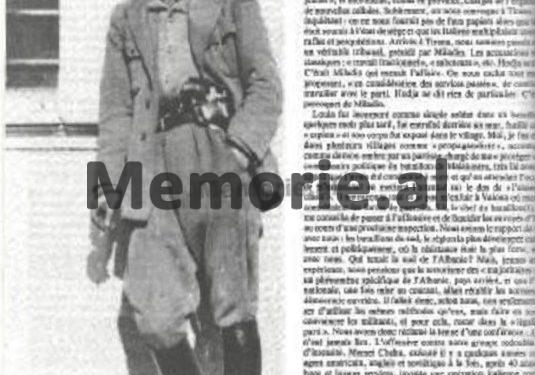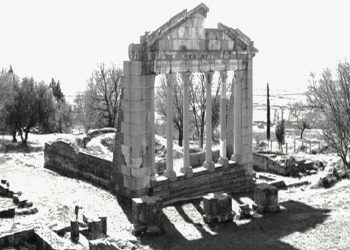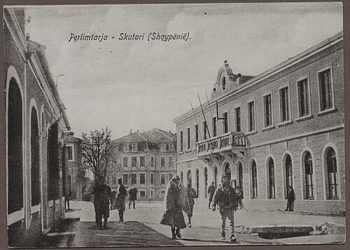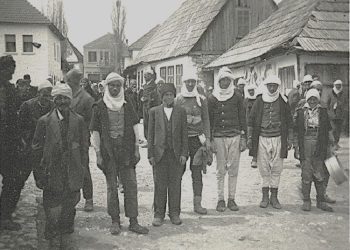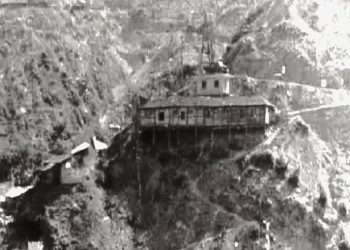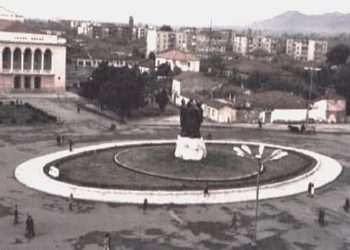By Ibrahim Vasjari
Memorie.al / Commemorating George’s War, of that generation that shed blood on the altar of the homeland, today we feel the pride of the anti-fascist victory, but also the pain of the wounds of the dictatorship, the shame of betrayal and the tragedy of fratricide. Going back in time and learning from the past, every nation uses historical memory to better move forward. This is what we should do in the service of the future, in the service of national progress, democracy and social peace.
The war in Gjorm and Gjormi in the war, in both cases the Gjormiots showed the country and Albanian history that they were wiser than demagoguery and more patriotic than fratricide. In the entire history of the war against the Nazi fascist invaders, you can hardly find a village like Gjormi where the war has so clearly shown its full character and features, where the war has removed its wild dance, under the ancient tam-tams and rhythms the new one, with a sad harmonization of the traditional epic, with the contemporary Albanian tragedy.
Seen from this perspective, George has become a symbol.
How did George connect with Lufta? What does tradition say about this, what do the graves, the songs say? Gjormi, like all of Albania, had an ancient “contract” with Lufta. She never looked for it, instead she found it herself. The war was foreign, while George is autochthonous. She always raged like a bad plague, heartless, blind to crimes and atrocities, while George, never fainting, came face to face with a manly man.
George had not been lulled by the murders, his heart had not given up even when he was waiting for the boys’ mandates, but he stood on his feet, did double duty and blew fire against evil, always here in his own land, stuck to the sides of the mountain, with a house, courtyards and stone roads, with the river underfoot and pastures and stables above. The war came from afar, while George usually waited there near the bridge, steadfast and persistent in his centuries-old survival.
From the Pelasgian caves to the new houses at the foot of the mountain, you had taken those few steps in thousands of years to your land, to your mountain and pastures. Lufta worked steel and gunpowder, while Gjormi grazed the flocks in the mountains, worked the milk, pulled the wool into the wood and beat the shajak into the slats.
When “the second Italy” came out of the sea, as they called it in these parts, George faced the War again. The war was like all the others, and Gjormi was the same as he had been: he had cleaned the houses, educated the boys and rejuvenated himself. Like all of Vlora and Labëria, Gjormi rose up in the war against the occupiers. But how would this war unfold?
There was a tradition for this. Especially in Vlora, the memory of the War of the ’20s was still fresh, its spirit, heroism, optimism was alive, but above all national unity, brotherhood, this fundamental article of the Albanian code of war. The arrival of the “second Italy” badly disturbed the national spirit of the people of Vlonia. The 1920s woke up, the memories, the songs woke up, and the graves trembled. And the war began.
Let’s give a detailed chronicle of the War of Gjorm and Gjorm at war: January 1942. In Gjorm the first illegal meetings for the organization of the war are held. Representatives of different political currents take part. In the guerilla unit of Vlora, the Gjormiots belong: Qani Shenaj (“Xhazhanezi”) and Arap Shenaj.
March 1942: The first illegals came out of Gjormi: Sadik Premte (“Jepi”), Neki Imeri (“Vangjo”) and Qani Shenaj (“Xhaxhanezi”). The first combat unit is formed in Gjorm, with Neki Imer in charge of the military, for the entire area of Mesaplik. In this unit with 13 people, 9 were from Gjormi.
April 1942: The territorial detachment of the village of Gjorm was formed with 40 people, with Commander Lulo Lulaj (“Malesori”), without any party bias. Albanians of all persuasions had united to liberate Albania.
December 4, 1942: “Ceta Plakë” was formed in Gjorm with Commander Neki Imer and 2, out of 3 team commanders in total, were boys from Gjorm: Qani Shenaj and Bako Tafili, while in this area, the nationalist squad “Shqiponja” with commander Hysni also operated. Lepenica.
December 16, 1942: Action in Izvor. It is wanted by the Superior Command of the Carabinieri, Ali Radhima, Neki Imeri and Shyqyri Alimerko.
December 26, 1942: Action in Radhima.
December 30, 1942: Numerous Italian forces led by Colonel Klementis and mercenaries from Dibra e Mati commanded by Halil Alia and Selim Kaloshi burn and loot Tragjas.
December 31, 1942: Starting from two directions, from the Tragjas Mountain and from the Vlorë-Mesaplik highway, the Italian fascist operation heads towards Gjormi. The war begins. In defense of George and the entire province of Mesaplik, there was a general popular mobilization. In Gjorm, the “Ceta Plakë” with Commander Neki Imer and the “Shqiponja” squad with Commander Hysni Lepenica operate – a battle already known by everyone.
January 1, 1943: At night, the communist headquarters, with Hysni Kapo in charge, gave the order to withdraw the forces, because the goal had been achieved. Twelve hours later, left alone, the “Eagle” detachment of Hysni Lepenica withdraws. The fascist and mercenary forces, until that time defeated and defeated, return to Gjormi, abandoned and unprotected!
January 2, 1943: Fascist repression in Gjorm. Cattle are robbed and slaughtered, a house is burned and 28 Georgian villagers are arrested.
January 10, 1943: George’s sons, at war again. Trench action.
February 21, 1943: The Selenica action.
March 16, 1943: Action in Cold Water Vlora, joint actions of communist and nationalist squads. From the Questura, Neki Imeri (“Vangjua”), Kujtim Bektash Cakrani from Ballshi and Qazim Çakërri from Tragjasi are wanted. Actions continue further in Sevaster, Patos, Mallakastër, everywhere with joint actions, everywhere George’s sons are at the forefront of the war.
Fascist Italy’s days were numbered. Belgrade with its emissaries near the leadership of the NPSH, seeing that the patriotic spirit was ardent in both anti-fascist camps, intensified the intervention and encouraged fratricide. Within the Albanian war, Albanianism had to be killed. Think what could be left of this war!
A strong bone for the Serbs was not only the nationalists, but also the fact that in the ranks of the leadership and the fighters of the communist squads, Albanianism was ardent. The stage of intrigue, behind-the-scenes, entrapment, backstabbing, and then the execution of fratricide began. For this reason, the anti-Yugoslav elements with strong Albanian tendencies in the Albanian Communist Party had to be eliminated first.
The aim of this strategy of Belgrade, at that time still invisible, hidden behind the mask of ‘anti-fascist liberation’, only 5 years later, became known worldwide, even the Titist plan for devouring Albania as the seventh republic of Yugoslavia, was also denounced from the NPSH itself, although “like the coffee after the harvest” and without any reflection on the crimes committed during the fratricide.
April 4, 1943: While the Fascist Quest, Sadik Premten and Neki Imer, the famous “Vangjon” of 24 anti-fascist actions, at the same time, the NPSH, with the direct participation of Dushan Mugoša, Mehmet Shehu, Hysni Kapo and Liri Gegë, prepares the trap for the physical elimination of these persons.
April 23, 1943: “Ceta Plake” of Vlora is asked for help by Mehmet Shehu in Mallakastër. At the same time, Sadik Premtja is urgently wanted in Tragjas. The trap for their physical elimination did not go exactly as the NPSH leadership had thought.
Sadik Premtja was informed that he would be ambushed and returned from the street, while Neki Imeri and his friends were arrested in Mallakastër. In an attempt to escape, the deputy commander of the “Old Squad”, Hydajet Micoli, and the commissar of the squad, Xhemil Çakërri, was killed, while Neki Imeri escaped and left tied and wounded.
“Ceta Plake” disbands. Sadik Premte, Neki Imeri and all the sons of Gjormi, already threatened by the Slavic-communist conspiracy, are taken under the protection of Hysni Lepenica and the nationalists. They were included in the ranks of the “National Front”, but again they did not withdraw from the Anti-Fascist War.
August 28, 1943: After Mukja. The communist headquarters based in Ramicë sends Shyqyri Alimerko and Sadik Zotaj from the newly formed unit “Hakmarrja” to kill Sadik Premten and Neki Imer. The ambush is set up in complete secrecy between Lepenica and Gjorm. The brave commander, Neki Imeri, was killed there, but the assassins, Shyqyri Alimerko and Sadik Zotaj, were also killed there by the armed boys from Giormi, who when they heard the crackling of rifles, came out and surrounded the place, cutting off the assassins’ way back to Ramica. .
Neki Imeri and Shyqyri Alimerko had been fellow fighters, they had once done so many actions against the fascists, the Fascist Quest had persistently sought them, the enemy sought them, but he could not kill them. The tragedy had begun. Albania was doing harakir. Dushan Mugosha and the Slavic-communist strategy had won.
September 1943: The battle of Drashovica against the new German occupiers. Gjorm’s sons again at war against foreigners, but this time without their commander Neki Imer. They fight against the Germans, when they return to the village they are protected from communist ambushes. Strange where they found that strength, that patriotism, that rare maturity and tolerance?!
And in September 1943, in Grehot of Gjirokastra, the brave commander Hysni Lepenica and the entire ‘Shqiponja’ platoon fell heroically in the war against the fascists. The popular poet laments in these verses:
“Ah, take Hysni Lepenica
If you were alive today,
Together with Neki Imer
The south would be land”.
Pain rises over Hysni Lepenica and Neki Imer. Something bigger than them had been killed, national unity had been killed, division had been sown, foreign institutes of Albanianophobia had won.
November 5, 1943: Numerous partisan forces commanded by Hysni Kapo and Mehmet Shehu attack Gjormi where, apart from the Albanians, there were no foreigners. First, Velça e Lepenica is taken, with hard efforts. The war in Gjorm takes place street by street and house by house. After that comes communist repression.
60 houses were burned (the Fascist operation had burned only 1 house), the village was looted, women and children were robbed. In the center of the village, among the flames and smoke of the burnt houses, among the crying children and the women in distress, the partisans started a dance:
“Where are George’s boys going?
Who do you leave the yellow ones to?
Those who took the dance were all shamefully Albanian, while Gjorm’s “leshverdhas” and “shamizezas” were tragically Albanian. Those who took the dance were forever shamed, while George’s women eternally honored.
Wild winter 1943-4944
George without food, without shelter, without protection. From time to time there were mandates of boys killed by fascists and communists. Within 20 days, 7 killed and 6 wounded.
January 1944: German forces line up to be shot in the center of the village of 15 and over.
February 7, 1944: Partisan forces again towards Gjorm. The villagers: old men, women and children, left the village and settled in the hills around Vlora, where they stayed for 8 months. Everything reminds you of the Greek massacre of 1914 and the relocation of Kurveles to Vlora. By autumn, the number of boys killed reached 23 (10 killed by fascists and 13 by communism), of which only 5 people knew their graves.
October-November 1944: Vlora and Albania were liberated. The tragic migrants of Gjormi, prey to the brutal fascist and communist repression, began to return to the village piece by piece with the languor of memories and the nightmare of tomorrow. Only 7 boys went into exile. After that, for Gjorm, as for all of Albania, the long ordeal of the communist dictatorship began: prisons, exiles, persecutions.
The chronicle is long, clear, and eloquent. Why did this happen to George? Gjormi, like all of Albania, had an ancient contract with Lufta. The war was foreign, while George is autochthonous. He, like few others and earlier than others in this world, understood that communism, like fascism, was foreign, a violent invader.
The tragedy of this finding was that the communists were Albanians and George could not fire a rifle against his brothers. He never attacked Albanians, never set up an ambush or traps, on the contrary, he defended himself, was martyred, cried out with despair, with pain against fratricide. It was difficult then to understand that communism was foreign, but Gjormi with experience and intuition noticed that something essential had been violated in the Albanian code of war.
The ancient word of faith and brotherhood in the war against foreigners had been forgotten, all Albanian covenants had been shamelessly violated, from the Assembly of Lezha and the League of Prizren, to Peza and Mukja, the moral basis of all our wars had been struck, the nerve had been paralyzed of survival, the national progress was called into question, the fundamental article of the ancient Albanian code of war was violated in a criminal manner and with criminal intent.
Without denying it, but also without idealizing history, it must be said that we Albanians have not always been rational to earn enough in proportion to the blood we have shed. On the contrary, we had rare and sudden victories and successes, while the nights of captivity were long. We have been narrowing as a territory, but we have managed to survive by being united and reacting as a single body to the permanent danger of national annihilation.
The 40s were a key moment in the history of Albania. We were given the opportunity to, after the war, lined up alongside the anti-fascist allies; finally enter the democratic family of Europe. In addition to the general patriotic spirit, in Albania at that time there was an unprecedented flowering of the market of political ideas.
At the debate table there were nationalists, proponents of Renaissance, conservatives, liberals, fanatics, Zogists, social-democrats and communists. Nice. The market of ideas promised a democratic future after Liberation. But precisely at this key moment in history, as in many other times, the foreign institutes of Albanianophobia have thought more about Albania.
The Serbian institute, along with the Greek one, has for centuries elaborated an entire Albanian-killing science. Belgrade’s hand has been and remains present in all external anti-Albanian machinations, just as it remained present for a while in all internal movements interfering in Albanian political life.
In the 40s, we had a national historical chance, but the Serbian institute also had another chance to kill and paralyze Albania’s progress, it had in its hands ‘a card’ never played and unknown by Albanians: communism.
Belgrade, through its emissaries in Albania, Miladin Popovic and Dushan Mugosha, founded and practically took over the NPSH, as well as through Titist blind tools, such as: Enver Hoxha, Mehmet Shehu, Hysni Kapo and Liri Gega, ensured as early as in beginning with the monopoly of leading the war, putting at the service of this anti-Albanian conspiracy the entire arsenal of demagoguery, disloyalty and communist crime, sophisticated with patriotic slogans against fascism and its “collaborators”.
Some internal circumstances, such as the lack of pluralist tradition and parties together with the problem of political power that would be decided after the war facilitated the victory of the bloody Slavic-communist adventure in Albania. Communism and fascism, these two classic forms of political extremism and dictatorship had come to power in Europe as early as the early 20s.
Communist ideas had entered Albania as early as the 30s, passing the initial stage of “Marxist romanticism”, sometimes as a philosophical and intellectual curiosity, sometimes as a social dream, something between aspiration, adventure and utopia. While the black shirts of fascism came brutally with bayonets, communism was planted and sprouted here by the titist hand that really had the leadership monopoly of the NPSH.
From the way these two ideologies entered Albania, from the fact that one was an invader, while the other called for a war of liberation, from the fact that one was a foreigner, while the other was Albanian, it goes without saying that communism at that time had advantages, was more popular and it was skillfully used by the Ustallars of Belgrade and their tools at the head of the NPSH to divert our anti-fascist struggle and put it at the service of establishing a dictatorship in Albania.
Hiding the final goal of the NPSH behind slogans for a liberation war and, for a democratic Albania, the use of demagoguery, the elimination of influential people, nationalist personalities and democrats inside and outside the NPSH, the use of intrigue, violence, terror and of disloyalty were the basic weapons that achieved the victory of the Slavic-communist conspiracy in Albania.
At that time it was really difficult to understand the threads of this conspiracy and the magnitude of the tragedy. Gjormi, however, was among the first to notice that even communism was foreign, that division, terror, fratricide were foreign again, that the Albanian code of war had been criminally violated.
More than 50 years have passed since then. At the end of this millennium, Gjormi, sewn as always on the side of the mountain, with the river under his feet and the pastures and stables above him, stubborn in his survival, a metaphor of existence and eternity, today has cast his gaze to the future, conveying the great message for reconciliation and national unity. Memorie.al





